|
Antarctic Demolition is Underway
Satellites
shows B-15a iceberg scraping the Antarctic sea ice and shattering it
01.06.05
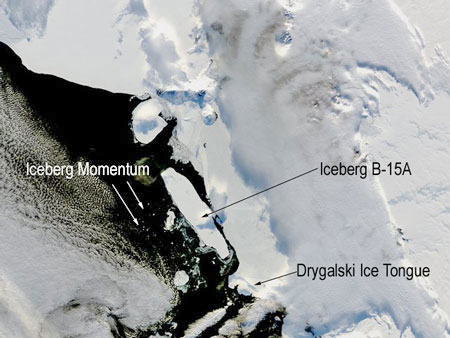
It is an event so large that the best
seat in the house is in space: a massive iceberg is on a collision
course with a floating glacier near the McMurdo Research Station in
Antarctica. NASA satellites have witnessed the 80-mile-long B-15A
iceberg moving steadily towards the Drygalski Ice Tongue.
Though the
iceberg's pace has slowed in recent days, NASA scientists expect a
collision to occur no later than January 15, 2005.
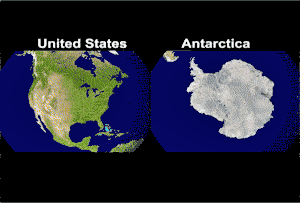
Click image to see
animation
Image
top: The Moderate Resolution Imaging Spectroradiometer (MODIS)
instrument
on NASA's Aqua and
Terra satellites captured the above image and others recently.
Image left: The MODIS instrument on NASA’s Aqua and Terra
satellites captured
13 images of the
shifting B-15A iceberg between November 9 and January 2, 2005.
The Iceberg is also
compared to the size of Long Island, New York.
"It's a clash of the titans, a radical and uncommon event," says
Robert Bindschadler, a researcher at NASA's Goddard Space Flight
Center, and if the two giant slabs of ice collide, we could see one
of the best demolition derbies on the planet. "Even a 'tap' from a
giant can be powerful. It will certainly be a blow far larger than
anything else the ice tongue has ever experienced," says
Bindschadler.
When the iceberg and the ice tongue collide, the impact will likely
"dent their bumpers," says Bindschadler. The edges could crumple and
ice could pile or drift into the Ross Sea. But if the B-15A iceberg
picks up enough speed before the two collide, the results could be
more spectacular. The Drygalski Ice Tongue could break off.
The ice tongue is thick ice that grows out over the Ross Sea from a
land-based glacier on Antarctica's Scott Coast. "Ice tongues do
break off on occasion," says Bindschadler. "It would only take one
thin area on the ice tongue to make it break off." There's no
guarantee that the Drygalski Ice Tongue will break off, but "this is
the toughest blow it has ever had to deal with."
"That Ice tongue has no reason for staying intact" says Waleed
Abdalati, researcher with NASA's Goddard Space Flight Center, but
Bindschadler points out, it may not break up either. The results
depend on the movement of the B-15A iceberg.
The B-15A iceberg is a 3,000-square-kilometer (1,200-square-mile)
behemoth that has a history of causing problems. It is the largest
fragment of a much larger iceberg that broke away from the Ross Ice
Shelf in March 2000. Scientists believe that the enormous piece of
ice broke away as part of a long-term natural cycle (every 50-to-100
years, or so) in which the shelf, which is roughly the size of
Texas, sheds pieces much as human fingernails grow and break off.
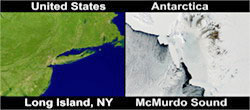 Image right: A comparison of Iceberg B-15A and Long Island, New
York. Image right: A comparison of Iceberg B-15A and Long Island, New
York.
The berg initially drifted toward McMurdo Sound and grounded near
Cape Crozier on Ross Island. It has since broken into pieces, the
largest of which is B-15A.
This year, B-15A has trapped sea ice in McMurdo Sound. The currents
that normally break the ice into pieces and sweep it out into the
Ross Sea have not been able to clean out the Sound, so winter's
thick ice remains intact.
The build-up of ice presents significant problems for Antarctic
residents. Penguins must now swim great distances to reach open
waters and food. Adult penguins may not be able to make the trip and
return with food for their young. As a result, many chicks could
starve, says Antarctica New Zealand, the government organization
that oversees New Zealand's Antarctic research, in the Associated
Press.
The National Science Foundation (NSF) officials said that the B-15A
iceberg and the frozen Sound will not interfere with supply ship
access to McMurdo Station, the U. S. logistics hub for much of the
nation's research activity in Antarctica. Forty miles of ice
typically separate the pier at McMurdo from the open sea, but this
year the ice stretched 80 miles from the station. So far, the extra
ice has not been a problem. The U.S. Coast Guard icebreaker Polar
Star left Seattle, Washington, on Nov. 4 and docked at McMurdo in
early January after cutting a channel through the ice for supply
ships.
Ironically, a collision between the iceberg and the ice tongue could
make things easier for both penguins and ships. If the ice tongue
collapses, the way may be opened for sea ice to escape the Sound.
There is no guarantee that satellite will see a great demolition
because the berg's fate is unclear. The berg's future depends on
unpredictable winds, tides and other forces, but possibilities
include colliding with the floating Drygalski Ice Tongue, or
continuing north, eventually melting.
If the collision occurs as predicted, this could be an event that we
witness again and again. The tides that drive the iceberg's motion
tend to push it in circles. "If B-15A bangs the ice tongue once, it
could bang it again," says Bindschadler. With multiple daily views
of the Ross Sea, NASA satellites will be there to watch the show.
Go
Back
Antarctic Demolition is Underway
Scientists
witness hundreds of cracks in the sea ice
01.19.05
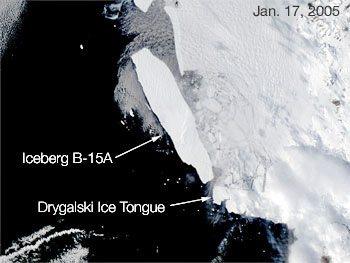
The Moderate
Resolution Imaging Spectroradiometer (MODIS)
instrument on
NASA's Aqua and Terra satellites captured the above
image January 17, 2005 and others recently.
Car demolition derbies last minutes, but
when it comes to a giant iceberg near Antarctica it takes a bit
longer. The Moderate Resolution Imaging Spectroradiometer (MODIS) on
board the Terra and Aqua satellites captured images of iceberg B-15A
steaming a steady course towards the extended Drygalski Ice Tongue
and scientists expected the Long Island, NY sized berg to initiate a
colossal collision by January 15.
Instead B15A appears to have
grounded on a submarine shoal when it was just 2.5 miles from the
glacier. Continued observations of the area on the eve of what is
expected to be renewed iceberg movements have shown a sudden break
up sea ice around the iceberg.
These waters pass through an annual cycle in which thick ice freezes
on the water during Antarctica's frigid winter, then breaks and
drifts into the Ross Sea during the summer. By mid summer in
January, much of this ice has typically been swept from the area.
This year, the process was disrupted by the giant B-15A iceberg.
Topping 129 kilometers (80 miles) in length, the Long Island-sized
iceberg blocked the currents that usually clear out this ice. As
late as the first week of January, the sea ice remained intact.
The
frozen expanse of water between the shore (left) and the open sea
(right) had been a serious problem for penguins, which had to travel
a greater distance to reach open waters and food. Though adults were
probably able to make the trip to feed, scientists feared the adults
would have to consume most of the food they were bringing to their
chicks because of the increased length of the return journey. While
the breaking ice may shorten the trip and bring relief to the
penguins, it is not clear if the changing conditions will save
penguin chicks from starvation.
The ice was also a potential problem
for supply ships trying to reach McMurdo Station and Scott Base.
Instead of cutting through the usual 64 kilometers (40 miles) that
separate the pier from open waters, icebreakers had to chart a
course through 129 kilometers (80 miles) of ice. The icebreaker
succeeded in reaching McMurdo in early January.
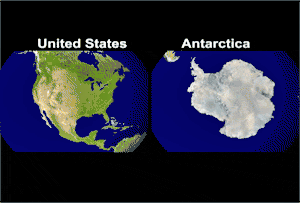 Image right: The MODIS instrument on NASA’s Aqua and Terra
satellites captured several images of the shifting B-15A iceberg
between November 9, 2004 and January 17, 2005. The Iceberg is also
compared to the size of Long Island, New York.
(click image to see animation) Image right: The MODIS instrument on NASA’s Aqua and Terra
satellites captured several images of the shifting B-15A iceberg
between November 9, 2004 and January 17, 2005. The Iceberg is also
compared to the size of Long Island, New York.
(click image to see animation)
The image also reveals that the B-15A iceberg has drifted away from
the Drygalski Ice Tongue. The massive iceberg had been on course to
strike the ice tongue in what could have been a collision of giants.
The Drygalski Ice Tongue is a floating extension of a land-based
glacier. Such ice tongues have been known to break under smaller
strains, and according to NASA scientist Robert Bindschadler, the
Drygalski Ice Tongue has never experienced a blow of the magnitude
that B-15A could deliver.
The iceberg had been moving steadily
towards the ice tongue, but its movement slowed in late December.
Just as the gap between the two narrowed to less than 2.5 miles (4
kilometers) , the iceberg rotated slightly and may have become
grounded. By January 13, the gap widened as the iceberg appeared to
reverse its course, perhaps in response to being grounded, says Bindschadler
Go
Back
|



 Image right: A comparison of Iceberg B-15A and Long Island, New
York.
Image right: A comparison of Iceberg B-15A and Long Island, New
York.
